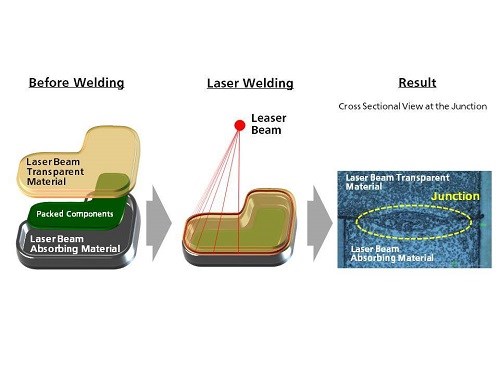Panasonic to Mass Produce PBT Compounds for Laser Welding
New laser weldable PBT compounds targeted to enhancing design flexibility and reliability of auto switches and sensors.
New laser weldable PBT compounds targeted to enhancing design flexibility and reliability of auto switches and sensors.
In its plans to further invest in its role as an automotive supplier, Japan’s Panasonic Corp., through its Panasonic Automotive Systems Company (U.S. office in Peachtree City, Ga.) has developed PBT molding compounds for laser welding. Mass production will commence next month.
Panasonic expects these compounds will enhance the flexibility of design as well as long-term reliability of automotive switches and sensors. Based on Panasonic’s data, the new compounds boast the following features:
- The industry’s highest laser transmittance, which enables a high welding strength.
• Laser transmittance: 72% (52% for Panasonic’s conventional PBT compounds.)
• No air leak found under the air pressure (3 atm) in water after a high-temperature, high-humidity storage test—after 1000 hrs of exposure to 185 F and humidity of 85%; or, a temperature cycling test—temperature range of -40 F to -184F.
- Stable quality and performance are ensured with low warpage of molded parts, and this contributes to the enhancement of the design flexibility of automotive components.
• Warpage: 0.5 mm (0.02 in.) or less compared to 2.3 mm (0.091 in.) for the company’s conventional grades.
- Excellent hydrolysis resistance enables the water resistance for small-to-large automotive components.
• High-strength retention rate after a high-temperature, high humidity storage test (as noted above): 94% vs 50% for the conventional compounds.
Currently used processing methods for the production of automotive sensors include sealing with packings and bolts, bonding with adhesive agents, as well as ultrasonic welding. Meanwhile, fast and efficient laser welding is increasingly becoming automakers’ favored assembly option, particularly since its high welding strength can shorten the bonding time and increase productivity.
However, plastic molding compounds generally used for laser welding have had low laser transmittance, leading to compromised welding strength and waterproof properties. The new compounds reportedly overcome these limitations. They will showcased at two upcoming shows: The LED show, March1-3, Santa Clara, Calif.; and, Highly-Functional Material World 2016, April 6-8, 2016, Tokyo Big Sight.
Read More:
Laser-Transparent PBT in Novel Air-Flap Control Unit
How to Select a Plastics Assembly Process
Search for nearly 100,000 grades of polymers on the Universal Selector by clicking here: http://www.ptonline.com/materials

Related Content
-
Can Plastic Recyclates be Welded Ultrasonically?
What is possible with ultrasound? Will the result with recycled plastics material actually be worse than with standard material? Do we have to adapt our technology?
-
X-Ray Vision Inside Parts Gets More Affordable for Processors
Shimadzu’s new benchtop x-ray CT scanner provides internal and external metrology and flaw detection at a fraction of the previous cost.
-
Cold Jet Builds New Cincinnati Headquarters
Cold Jet is consolidating two Cincinnati-area facilities into one location.















